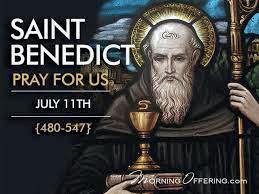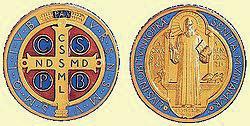
4 minute read
Saint Benedict - Powerful Protector
By TOM DENNEHY
Saint Benedict and his twin sister, Scholastica, were born in the year 480 into a Roman noble family. He grew up with the expectation that he would follow his family wishes for a career in Roman government. However, he was not impressed by the immoral lives of others in his generation and at about the age of twenty, he retreated into a cave at Enfide. There, for three years, he lived as a hermit. As he matured in wisdom, age and grace, others noted his qualities and invited him to lead the local community of monks. At first, they did not do well as the monks resisted Benedict’s effort to bring great spiritual discipline to their lives. Benedict escaped their attempts to poison him by miraculous means, once with a cup of poisoned wine, shattering as he blessed it. Next the monks tried to poison his bread. After blessing the bread, a raven flew in the window, picked up the bread and flew off with it. At this time, St. Benedict left the monastery to return to his cave in Subiaco. While living there, his reputation for sanctity became known throughout the region and many began to visit him seeking his guidance. Many miracles took place during this time.
Benedict went on to establish twelve monasteries, the most important of which was the Benedictine Monastery in Monte Casino where he died in 543. St. Benedict established rules for monastic life and this was his great legacy. He desired to create a model of monastic life that would make it possible for ordinary men to follow every day. He also wanted to create a community, with the abbot as the father, guiding the monks in the daily practice of work and prayer. The idea was that physical labour can be dedicated to God and be a means by which men and women can work out their salvation. St. Benedict summed up his ideal in the rule of St. Benedict which became the foundation document of Western Christianity. It deals with how each monk may live each day with his mind on Christ as he works and prays. It also deals with the duties of the abbot as father leading the community.
The Medal of Saint Benedict.
The Saint Benedict medal is a powerful sacramental in the Catholic Church known for its association with protection against evil and temptation. It is a symbol of faith, protection and a connection to the spiritual power associated with Saint Benedict.
The medal features Saint Benedict holding a cross and his monastic rule on one side and on the other, the inscription “Vade Retro Satana” which means Be Gone Satan. Other prayers are included highlighting its association with exorcism and protection against evil. It is often recommended by priests and exorcists as a means of protection against demonic influence and temptations.
The medal is not just a physical object, but a symbol of faith and a conduit for grace, with its power stemming from Christ and the fervent prayers of those who use it. Many Catholics wear the medal, often around their necks or attached to other items, as a reminder of Saint Benedict’s intercession and a source of comfort and strength. Many rosary beads today contain the medal and cross of St. Benedict.
Miracles and TestimoniesStories of miraculous events, like the fire at Metten Abbey in Germany bypassing the building, due to the prayers of the monks and the presence of the medal, further solidify its reputation as a powerful sacramental.
Saint Benedict, along with St. Joseph, is patron saint of a happy death.
The medal is also considered effective in asking for inner peace/spiritual healing; asking for peace between individuals or nations of the world; curing bodily afflictions especially as protection against contagious diseases; destroying the effects of witchcraft and all other diabolical and haunting influences; healing those who are suffering from wounds or illness; obtaining the conversion of sinners, especially when they are in danger of death; offering protection against storms and lighting; protecting children from nightmares; protecting a mother and her children during childbirth; protecting animals infected with plague or other maladies; protecting those persons, who are tempted, deluded or tormented by evil spirits.
On the medal of St Benedict are found letters which are an abbreviation for a powerful prayer of protection. The translation is -- May the Holy Cross be my light. Let not the dragon be my guide. Begone Satan. Never tempt me with your vanities. All that pours from you is evil. Drink your own poison. Amen.
He is the patron saint of Europe and we celebrate his feast day on July 11th.












